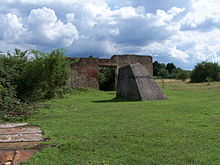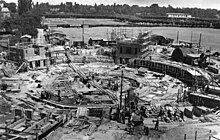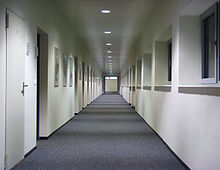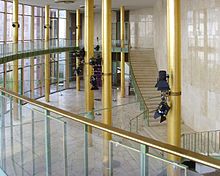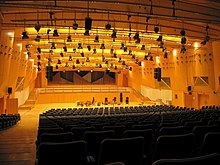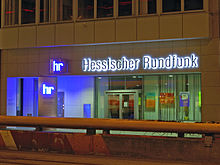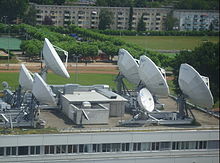Hessian radio
| Hessian radio | |
|---|---|
| Station logo | |

|
|
| General information | |
| Seat: | Frankfurt am Main |
| Intendant: | Manfred Krupp |
| Radio: |
hr1 hr2-culture hr3 hr4 hr-iNFO You FM hr1 plus (former) hr-classic (former) hr-chronos (former) hr-info plus (former) hr XXL (former) hr-skyline (former) |
| Watch TV: | hr television |
| Sound body: |
hr big band hr symphony orchestra |
| Legal form: | Institute of public right |
| Website: | www.hr.de |

The Hessischer Rundfunk ( hr , originally HR ) is an institution under public law ( Landesrundfunkanstalt ) for the state of Hesse with its seat in Frankfurt am Main . He is a member of the working group of the public broadcasters of the Federal Republic of Germany ( ARD ).
history
Beginnings as Südwestdeutsche Rundfunkdienst AG
In the autumn of 1922, the Reich Ministry of Post had given up initial plans for a centrally broadcast German radio. At this point in time, Frankfurt am Main was set as the location for a transmitter that was to cover the region between Trier, Cologne, Kassel, Würzburg and Stuttgart. In the late summer of 1923 the principle of regional programming also prevailed in the ministry. The driver of the development was the state-controlled society Deutsche Stunden . However, no state funds were allowed to be used to set up and operate the radio.
Several interested parties tried to obtain a broadcast license for Frankfurt from the Ministry of Foreign Affairs. In October 1923, the chemical entrepreneur Carl Adolf Schleussner prevailed and, on the initiative of Ludwig Landmann, the head of the economics department, also obtained the promise of financial support from the city's magistrate. Schleussner had built up a group of supporters from private individuals who were both ideologically and financially interested in radio technology, including the industrialist Fritz von Opel . In November and December, Schleussner and his colleagues negotiated with the Post Office and Ministry of the Interior in Berlin, the German Hour and with the Frankfurt City Council on financial and contractual details. At the same time, the Ministry of Post commissioned the Reich Telegraph Office to carry out measurements for the construction of a radio transmitter in Frankfurt. On December 7, 1923, the notarial establishment of the Südwestdeutsche Rundfunkdienst AG (SWR) took place, against the will of the then Mayor of Kassel and former Chancellor Philipp Scheidemann , who wanted to bring the broadcasting company to Kassel. The initial capital was 100 trillion paper marks, later converted to 60,000 gold marks. A week later, the same people founded Aerophon AG for the distribution of radio receivers, which, however, was liquidated two years later. This was followed by further negotiations on the license agreement and advertising for the upcoming broadcasting operations on various channels. On February 2, 1924, SWR was entered in the Frankfurt commercial register. On February 4th, construction work began on the transmitter antenna at the Frankfurt Post Office in Senckenberg (now Stephan) and the corner of Stiftstrasse.
A trial phase followed in March 1924. On March 17, the SWR received a provisional broadcasting license from the Reich Ministry of Post, because there continued to be disputes with the Reich Ministry of the Interior and later also with the Reich states about the final concession agreement over the next two years. On April 1, 1924, the transmitter Frankfurt I began transmitting with a transmission power of 700 watts at 460 m wavelength. The transmitter and recording room as well as an “artist's room” were located on the fifth floor of the post office, the administration rooms were in Schleussner's company building at Elbestrasse 50. 546 listeners had registered at the post offices for a monthly fee of two Reichsmarks. In 1925 the company became a member of the Reichs-Rundfunk-Gesellschaft (RRG). In 1926, Radio Frankfurt put the 1.5 kW transmitter Heiligenstock into operation. In 1930 Radio Frankfurt moved into its own broadcasting house on Eschersheimer Landstrasse . On March 1, 1926, after the political disputes at the national level had been resolved, the SWR and the other broadcasting companies were given final approval for radio operations. At the same time, cultural advisory boards and political monitoring committees were formed for the broadcasters . This process was partly accompanied by political disputes and dragged on for the SWR until the beginning of 1927.
The first artistic director was the doctor Hans Flesch, known for his love of experimentation . He came to the station in 1924 and won over writers and philosophers such as Bertolt Brecht , Walter Benjamin , Theodor W. Adorno and young composers such as Paul Hindemith, who was related to him by marriage . In the summer of 1924, Flesch received the similarly innovative Ernst Schoen in the position of artistic assistant. In 1929 Flesch changed to the Berliner Funkstunde as director . From autumn 1924 on, Carl Stueber strengthened the station's profile with a view to classical music. From mid-1925 on, Paul Laven produced reports on sporting events and everyday life in Frankfurt.
In the first year it was broadcast between three and five hours a day, from March 1925 onwards it was broadcast around seven hours a day. A message block was set from 11:55 a.m. to 12:10 p.m., and light music from 4:30 p.m. to 6 p.m. A concert followed from 8:30 p.m., followed by late-night news. Occasionally a lecture was added at 7:30 p.m. and dance music from 9:50 p.m. Lectures and advanced training courses were produced in cooperation with Frankfurt public education institutions, local media, the Chamber of Industry and Commerce and the municipal health department. The station commissioned the composer Ernst Krenek with a first commissioned production under the title Radio Blues and Hans Flesch wrote and produced a first radio play under the title Zauberei on the station . Also in the first year of broadcasting, competitions for singers and poets, request concerts and a "mailbox" were established in which broadcasts from listeners were read. Flesch's involvement in particular gave the Frankfurt broadcaster the reputation of an innovative, liberal medium, even if political statements were prohibited in the program.
The program was initially not allowed to be received in the Allied occupied areas on the Rhine. At the end of 1925, the Allied administration relaxed this ban. With the end of the occupation in 1930 it became invalid.
After Kassel's application for the seat of the regional broadcaster was unsuccessful, radio fans there stayed active and founded the Cassel interest group for German broadcasting in April . In the following months they obtained approval from the Reich Ministry of Post for a local intermediate transmitter to amplify the radio signal from Frankfurt, which was poorly received. This was put into operation on December 21, 1924 in the Oberpostdirektion, Hohenzollernstrasse 24. With a frequency of 288 m, which differs from the Frankfurt transmitter, and facilities for direct broadcasting, the conditions for an independent program have been created. Two days before the start of the broadcast, the theater director Karl Block was hired as head of the Kassel SWR branch. Only at the turn of the year 1924/25 was there a telephone connection with which the program from Frankfurt could be transmitted to the Kassel transmitter. On January 10, 1925, the Frankfurt broadcaster first broadcast a concert played in Kassel.
The project of an intermediate station based on the Kassel model in Mannheim, initiated at the end of 1924, failed not least because of the resistance of those responsible for broadcasting in Stuttgart and Bavaria. On April 30, 1926, a meeting point in Mannheim went into operation, which was operated jointly by the Frankfurt and Stuttgart broadcasters.
By the beginning of 1927, the number of radio subscribers in the Frankfurt broadcast area increased to just under 103,000.
In National Socialism: Reichsender Frankfurt
After the takeover of the Nazis 1933 nationalization of the transmitter takes place; In 1934, SÜWRAG was renamed Reichssender Frankfurt . The program was redesigned according to the will of the National Socialists and from then on, under the director Hans-Otto Fricke, it served to spread National Socialist propaganda. During the Nazi dictatorship, the station was under the control of the Reichs-Rundfunk-Gesellschaft, which was transferred to the newly founded Großdeutscher Rundfunk in 1939 .
After the war: from Radio Frankfurt to HR
1945 founded American occupying power the transmitter Radio Frankfurt . After the destruction of the old radio house and the transmitter on the Heiligenstock , the Americans broadcast from temporary studios in nearby Bad Nauheim (Radio Bad Nauheim). In the spring of 1946, the transmitter moved back to the poorly restored old broadcasting house on Eschersheimer Landstrasse in Frankfurt. The radio was the most important source of information for Germans in the post-war period.
The "Goldhalle", the foyer of the broadcasting room
After long debates and under pressure from the Americans, the Hessian state parliament passed the "Law on Hessian Broadcasting" on October 2, 1948. It states under § 1: “The Hessischer Rundfunk is hereby recognized as an institution under public law with its seat in Frankfurt a. M. erected. He has the right of self-administration and is not subject to state supervision. ”On January 28, 1949, Intendant Eberhard Beckmann was handed the broadcasting license in the presence of US General Lucius D. Clay . The Americans thus transferred responsibility to the Germans.
In 1951, the young broadcaster moved into its new premises in the Dornbusch district, which had actually been planned as the seat of the German Bundestag and some of the shell had already been completed. On May 10, 1949, the Parliamentary Council decided against Frankfurt and made Bonn the provisional federal capital. The so-called "round building", in which all radio studios were housed until 1999, was originally intended to be used as the plenary hall of the German Bundestag. The round building was built based on the also round Frankfurt Paulskirche to commemorate the Paulskirche constitution of 1848. The listed “Goldhalle”, which should have become the anteroom to the plenary hall of the Bundestag and which is now used as an exhibition room and as part of the foyer of the broadcasting hall that was later added to the side, still reminds of this function intended for the building.
Radio bloom in the 1950s
The early popular radio programs included the “ Bunter Evenings ”, quiz programs between London and Frankfurt, the morning entertainment program Frankfurter Wecker and the Hesselbachs, initially produced as a radio play . The Hessischer Rundfunk broadcast radio plays by Heinrich Böll and crime novels by Francis Durbridge . Alfred Andersch founded the cultural program " Evening Studio ", which until 2003 had a permanent place on the program. Names like Hans-Joachim Kulenkampff, Peter Frankenfeld or Heinz Schenk shaped the radio program of HR during these years. With the introduction of VHF radio in 1950, the Hessischer Rundfunk received a second program that quickly developed into a cultural program. In the same year he also became a founding member of ARD.
Emergence of television
In the early 1950s, the German broadcasters resumed the development of television programming that had been interrupted by the war. The first evening program from Frankfurt was broadcast in November 1953. On November 1, 1954, the broadcasting of the ARD community program Deutsches Fernsehen began. To separate the regionally broadcast advertising films in the evening program, the cartoon character Uncle Otto made his first appearance in 1958 and became the mascot of HR.
On May 1, 1961, Hessischer Rundfunk began broadcasting its own regional television program. After the establishment of the Second German Television (1961), the regional programs of the ARD stations were renamed “ Third Television Program ” (1964). From 1983 the regional program of the Hessischer Rundfunk was called Hessen 3, from 1998 hessen fernsehen and since 2004 hr-fernsehen.
Development of radio

On June 1, 1964, the third radio program hr3 went on air, initially mainly with programs for " guest workers ", from 1972 it was expanded to become a service wave for car drivers and from 1981 to a pop wave . On October 6, 1986, Hessischer Rundfunk strengthened the regionalization of its programs with the development of the fourth radio program hr4 . In addition to the existing studios in Kassel and Wiesbaden, additional studios were set up in Bensheim, Fulda and Wetzlar. On January 5, 1998, the station started the so-called “plus programs”: the word program hr-chronos (initially hr1 plus), the classic radio station hr-klassik (initially hr2 plus), the youth program hr XXL , the business radio station “hr skyline” ( initially hr4 plus). In 2003, as part of a program reform, the word program hr-chronos was initially discontinued (on June 30); the medium wave now broadcast the hr-skyline program as well as programs for foreigners and parliamentary debates.
The youth wave XXL, which originally emerged from the hr3 evening program hr3-XXL , was restarted in December 2003 as You FM - also with a new musical direction.
The business radio hr-skyline, which initially broadcast music, was converted to an information program in 2002 and no longer broadcasts music on weekdays. In 2004 the station was expanded into a pure word program and was given the name hr-info .
The programs hr1 and hr2-kultur were also reformed in 2004, but kept their names. In June 2005 the station stopped the hr-classic program. This step was justified with urgently needed savings measures.
Today the programs hr-info and YOU FM are not broadcast extensively on VHF due to a lack of available frequencies. Until December 31, 2009, hr-info could be received nationwide via medium wave 594 kHz. MW 594 kHz was discontinued due to high electricity costs. The medium-wave transmitters Weiskirchen and Hoher Meißner were switched off at the end of the year as part of the austerity program announced in 2009, the transmitter masts in Rodgau-Weiskirchen were blown up on April 11, 2012. To improve the VHF coverage with both programs, the Hessischer Rundfunk rededicated several frequencies to basic network transmitters in 2005, and many frequencies of the former program hr-classic were switched to You FM or hr-info after it was discontinued.
In 2009 the Hessischer Rundfunk was awarded the German Critics' Prize for its radio play House of Voices .
Programs
Hessischer Rundfunk currently produces the following radio programs alone or in cooperation with other broadcasters :
Radio
- hr1 - Soft AC program (formerly information).
- hr2-culture - cultural program.
- hr3 - entertainment program ( pop wave ), formerly service wave .
- hr4 - light popular music, u. a. Bat. Daily disconnection for magazines from the regional studios.
- hr-info - information radio with news twice an hour as well as reports from politics, business, culture and sport.
- You FM - Jugendwelle (formerly: hr XXL ).
According to the Media Analysis (MA) published in February 2018, the six radio programs of Hessischer Rundfunk are heard by 2,334 million people over the age of 14 on working days.
watch TV
- hr television
- The first - joint program of the ARD
- Phoenix - joint event channel of ARD and ZDF
- KiKA - children's channel from ARD and ZDF
- ARTE - German-French cultural channel
- 3sat - cultural channel from ARD, ZDF, ORF and SRG SSR
- tagesschau24 ( ARD Digital )
- One (ARD Digital)
hr television
The hr-fernsehen is the regional so-called “third” television program on German television for Hesse. The name comes from the time in the Federal Republic of Germany only the German television (today: Das Erste) and the ZDF as full programs and the only regionally broadcast television programs were the third programs.
hr-fernsehen is characterized by regional information and entertainment programs, from the hessenschau to maintower to the large HessenQuiz . There are also news programs, documentaries, music programs, advice programs, culture magazines, feature films and reports.
Hessian television classics are:
- The Hesselbachs , from 1949 initially as a radio play, from 1960 to 1967 as a television series
- Commissioner Freytag (1963–1965)
- A place for animals with the Frankfurt Zoo Director Bernhard Grzimek (1957–1987)
- Doctor Murke's collected silence as well as Doctor Murke's collected obituaries , satire with Dieter Hildebrandt based on stories by Heinrich Böll
- Zum Blauen Bock with Otto Höpfner (1957–1965), later Heinz Schenk (from 1965), Lia Wöhr and Reno Nonsens (1957–1987)
- One will win (EWG), big Saturday evening quiz with Hans-Joachim Kulenkampff (1965–1987)
- Augsburger Puppenkiste (1953-2001)
- Pausing cats - pause fillers with playing kittens, since the mid-1970s
- Buddenbrooks , eleven parts (1979)
- Wonder of the earth (1968-2006)
- Giraffe, meerkat & Co. , zoo documentation (since 2006)
Participation in Das Erste
Hessischer Rundfunk contributes around seven percent to the television program Das Erste . Among many supplies for evening news , evening news , morning - and Mittagsmagazin , numerous feature films and contributions to individual programs, it provides the following transmission lines:
- ttt - title, theses, temperaments (since 1967)
- plusminus , business magazine (since 1997)
- Drawing of the lottery numbers (1965 to 2013)
- Tatort (1971–1979 with Klaus Höhne as Inspector Konrad ; Heinz Treuke (in the first episode) and Lutz Moik (in two further episodes) as Inspector Bergmann ; 1985–2002 with Karl-Heinz von Hassel as Inspector Brinkmann; 2002–2010 with Andrea Sawatzki and Jörg Schüttauf as commissioners Charlotte Sänger and Fritz Dellwo; 2011–2015 Joachim Król and Nina Kunzendorf as commissioners Frank Steier and Conny Mey; from 2010 with Ulrich Tukur and Barbara Philipp as commissioner Felix Murot and secretary Magda Wächter, and from 2015 with Margarita Broich and Wolfram Koch as Commissioners Anna Janneke and Paul Brix)
- The Hessischer Rundfunk has also been creating the “weather map” at the end of the Tagesschau since 1960 and for many years various weather reports for the broadcasts ARD-Morgenmagazin , ARD-Buffet and other editions of Tagesschau , including on the news channel tagesschau24 .
- Since January 1, 2020, the newly founded ARD weather competence center at Hessischer Rundfunk in Frankfurt has also been delivering the weather report on the daily topics .
- Since 2000 the Hessian Runfrunk has been producing the show Börse vor Acht for Das Erste .
- In addition, he produces reports and documentaries such as ARD-exclusiv, Der Tag, als ..., Das Rote Quadrat and the series Our 50s and Our 60s, either alone or in a leading role with other state broadcasters for Das Erste .
Program support
Internet
The programs of the Hessischer Rundfunk are accompanied by advertising-free offers on the Internet and by teletext . The internet portal of the Hessischer Rundfunk (www.hr-online.de) started in 1996. Today the hr internet portal provides information on radio and television programs as well as news from Hesse's politics, economy, sport, culture and society. At the same time, it is a platform for audience and user feedback and participation in program activities.
All radio waves can be received as a live stream in Windows Media or MP3 format , plus podcast and download offers from numerous categories or series. For example, hr2 provides the program Der Tag and the Funkkolleg ; in the case of hr-info, it is the self-produced weekend programs and series contributions. hr1 offers a broad spectrum from political satire to the CD of the week, hr3 for example cinema and book tips as well as popular comedy series. In addition to its audio podcasts, the youth broadcaster You FM also has a video podcast of the morning show in its program.
In addition, selected television programs are offered as video-on-demand, such as the news programs Hessenschau and Hessenschau compact, the weather show Alle Wetter, parts of the programs Mex, Meinungsmacher, Herkules and defacto and many more.
Under the Community ARD website ard.de the Hessian Broadcasting produced the stock market heading boerse.ard.de and uses the existing already on radio and television specialist expertise on financial market issues.
Knowledge and educational offers of the Hessischer Rundfunk are bundled under the address Wissen.hr-online.de .
On July 21, 2015, the Hessischer Rundfunk closed its previous website hr-online.de and started it again as hessenschau.de.
Teletext
On June 1, 1985, the Hessischer Rundfunk launched a teletext service. There are now over a thousand information boards available. Around 300,000 viewers read the hr teletext boards every day, in particular news, weather, program information as well as sports results and tables from over 200 Hessian leagues in 15 sports. Other special features include the current flight schedule for Frankfurt am Main Airport with arrival / departure times and delays as well as environmental data from the Hessian regions.
All information from the television accompanying medium teletext can be called up on the internet at hr-text.de in a way that closely follows the original form.
orchestra
The Hessischer Rundfunk finances and maintains two orchestras of its own:
- Frankfurt Radio Symphony Orchestra (Frankfurt Radio Symphony) - The 1929 Radio Frankfurt (the predecessor of the Hessian Radio) founded Symphony Orchestra is an orchestra with an international reputation. With its 112 musicians, it presents the entire diversity of symphonic music through to contemporary music and also realizes innovative concert formats and experimental projects. Its main place of activity is the state of Hesse. It also makes guest appearances at major festivals at home and abroad and goes on tour around the world. Andrés Orozco-Estrada has been chief conductor of the Frankfurt Radio Symphony Orchestra since the 2014/15 season . Important former chief conductors of the Frankfurt Radio Symphony Orchestra were Dean Dixon , Eliahu Inbal , Dmitrij Kitajenko , Hugh Wolff and Paavo Järvi .
- hr-Bigband (Frankfurt Radio Big Band) - The hr-Bigband was founded in 1946 as the “Dance Orchestra of Radio Frankfurt” (later the Hessischer Rundfunk). Since the 1970s it has developed into a jazz big band with a focus on concert activities. With around 50 concerts per year, it covers a broad stylistic spectrum within jazz and dares to cross borders with classical music, pop, foreign musical cultures and electronics. After three years as “ Artist in Residence ”, Jim McNeely became chief conductor of the hr big band in 2011.
Studios, locations and correspondents
HR locations and correspondents in Hessen |

The headquarters of the Hessischer Rundfunk is the “Funkhaus am Dornbusch” in the Frankfurt-Nordend district on the border with the Frankfurt-Dornbusch district . The station also operates external studios in Hesse and Berlin as well as some ARD correspondent offices abroad.
Studio Kassel
The Kassel studio , located near the ICE train station in the Bad Wilhelmshöhe district, has existed since 1952. A separate building with production and broadcast studios for radio and television was built in 1970. Today's Kassel television studio is equipped with modern, fully digitized technology and was opened on September 16, 1994. Weekly magazines for hr television (e.g. Alles Wissen ) as well as the entertainment programs Dings vom Dach und Straßenstars as well as special programs - for example on local elections - are produced there. Every day the Kassel TV reporters provide information about the region in the Hessenschau and Hessenschau Kompakt . In addition, the television editorial team supplies ARD broadcasts with current reports from North Hesse, for example the Tagesschau, the Tagesthemen or Brisant . The TV editorial office science also produces articles for the ARD magazine W wie Wissen . Since 2005 there has been a weekly television magazine with reports from North Hesse on hr-fernsehen under the title Herkules . The radio program hr4 has been based in Kassel since 2004 . On September 3, 2017, the Kassel studio served as an ›asylum studio‹ for a program broadcast jointly by hr1 , hr3 and hr4 from 6:00 a.m. to midnight , because the Frankfurter Funkhaus was shut down to defuse a 1,800 kg bomb had to be evacuated in Frankfurt's Westend after World War II. Early in the morning one of the listeners summarized this joint program as "hr 8" (1 + 3 + 4), which the moderators referred to over and over again during the day. One listener suggested that "hr 8" be repeated every first Sunday in September of the year to commemorate this memorable merging of programs.
Studio Darmstadt
Studio Darmstadt , the second largest regional studio of the Hessian Broadcasting Corporation after Kassel, was reopened in May 2003 after renovation. It is a pure radio studio. Production and broadcasting studios are located there, from which the Rhein-Main program is broadcast by hr4 . The regional correspondents also serve the other radio programs with topics from Darmstadt and the surrounding area from here. Since some of the radio reporters also work as video reporters , the station is also supplied with current images from southern Hesse from here.
Studio Fulda
Studio Fulda has existed since 1986 and was equipped with digital technology after a renovation in 2004. It takes on the task of reporting for the Hessischer Rundfunk program on both radio and television from the East Hesse region . This is made possible, among other things, by the video reporters who work there for television programs such as the Hessenschau . In addition, the weekday radio regional window "hr4 Nord-Osthessen" of the state wave hr4 is broadcast from the Fulda studio. At the end of 2013, the studio was “downsized” like the other regional studios due to cost-saving measures, moved from Bahnhofstrasse to the upper floor of a RhönEnergie Fulda building and switched to a new production and broadcast method.
Further regional and field studios
- Studio Mittelhessen in Gießen (opened in 2001; previously since January 19, 1987 in Wetzlar )
- Studio Wiesbaden in the Hessian state parliament (since 1947; responsible for state parliament reporting as well as Wiesbaden and the Rheingau)
The hr television studio in Frankfurt's Main Tower , which had existed since 2000, was given up in October 2015. The tabloid magazine maintower continues to broadcast from a virtual studio under this name. The radio studio for hr-skyline was closed in 2004.
There are also regional correspondents in: Bensheim (Bergstrasse district), Erbach (Odenwald), Hanau (Main-Kinzig district), Korbach (Waldeck-Frankenberg), Limburg an der Lahn (Limburg-Weilburg district), Marburg (Marburg-Biedenkopf district ) and Witzenhausen (Werra-Meißner district). The regional correspondents work primarily for radio, but also provide pictures for television as so-called video reporters .
Correspondent studios
- HR office in the ARD capital studio in Berlin (on radio together with SR , RBB and RB , on television involved in the ARD joint television editorial team)
- HR-Studio Brussels (radio)
- ARD-Studio Madrid (radio and TV)
- ARD studio North Africa in Rabat (radio)
- ARD-Studio Washington (radio)
- ARD-Studio Los Angeles (radio)
- ARD stock exchange studio (radio & television)
- ARD-Studio New Delhi (a television correspondent since spring 2008)
Transmission systems and transmission technology

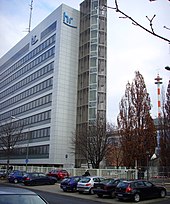
The Hessischer Rundfunk operates its own network for broadcasting its radio and television programs in Hessen. He also makes this network available to private broadcasters as a service provider for broadcasting. He also uses Media Broadcast and SWR broadcasting systems .
Own transmitter locations
- Hoher Meißner transmitter : VHF
- Transmitter Kassel-Wilhelmshöhe: VHF
- Biedenkopf transmitter : VHF
- Rimberg transmitter : UKW, DAB, DVB-T
- Marburg transmitter : VHF
- Transmitting systems on the Großer Feldberg : VHF, DAB, DVB-T
- Transmitter Frankfurt-Main-Tower : VHF
- Transmitter Frankfurt (Funkhaus Bertramstrasse): VHF
- Transmitter in Darmstadt Weiterstadt / Darmbach: VHF
- Würzberg transmitter in the Odenwald: VHF, DVB-T
- Transmission tower Hardberg am Odenwald: VHF
- Sender Schluechtern
Transmitting locations of the Deutsche Funkturm GmbH
- Telecommunication tower Habichtswald : VHF, DAB, DVB-T
- Hoher Meißner transmitter : DVB-T
- Angelburg TV tower : DVB-T
- Transmitting systems in the Europaturm / Frankfurt: DAB, DVB-T
- Heidelstein transmitter : VHF, DVB-T
- Telecommunications tower Hohe Wurz : DVB-T
Broadcasting location of the SWR
- Mainz-Kastel transmitter : DAB
Former transmitter locations
- Heiligenstock transmitter
- Weiskirchen transmitter : MW (not to be confused with the medium-wave transmitter Weißkirchen of AFN )
Legal basis
As an institution under public law, the Hessian Broadcasting Corporation needs a legal basis in which the program mandate, program principles and internal organization are specified. The law on Hessian Broadcasting of October 2, 1948, which forms this legal basis, was last amended on October 13, 2016. On June 5, 2007, there were extensive changes to adapt the so-called HR law to current media policy needs. The mission of the Hessischer Rundfunks is regulated in § 2 of the law: "The task of the Hessischer Rundfunks is to distribute news and presentations of an educational, educational and entertaining nature."
The Broadcasting Act is supplemented by an Interstate Broadcasting Agreement, which regulates the relationship between public and commercial broadcasting in the dual broadcasting system and which contains basic provisions, particularly on financing.
financing
The Hessian Broadcasting is financed by license fees (85 percent), advertising (5 percent) and other revenue (10 percent). 60 percent of the income goes to hr television, 28 percent to radio, 8 percent goes to technology and 4 percent to administration. In 2008 the broadcaster's license fee income was 391.8 million euros. The state parliaments set the level of the broadcasting fees in the form of a state treaty of all federal states. The basis for this is the recommendation of the independent commission to determine the financial needs of broadcasters (KEF).
organization
The organs of the Hessischer Rundfunk are the Broadcasting Council, the Administrative Council and the Director .
Broadcasting Council
The 32-strong Broadcasting Council elects the director and advises the director on fundamental issues relating to program design. The Broadcasting Council is also responsible for approving the budget, the annual accounts and the annual report, as well as discharging the administrative board and the director.
Board of Directors
The board of directors consists of nine members and has, among other things, the task of examining the budget estimate drawn up by the artistic director, the annual accounts and the annual report and submitting its opinion to the broadcasting council. The board of directors also oversees the management of Hessischer Rundfunk.
Intendant and management
The director leads and administers the Hessischer Rundfunk. He designs the program in accordance with the Hessian Broadcasting Act. Four directorates report to the director:
- the radio directorate (since August 1995: Heinz-Dieter Sommer)
- the television directorate (since March 4, 2016: Gabriele Holzner)
- the legal management (since February 2017: Nina Hütt)
- the operations management (since October 1, 2009: Berthold Tritschler)
Manfred Krupp has been the director of Hessischer Rundfunk since March 1, 2016 . The former hr television director was elected by the Broadcasting Council to succeed Helmut Reitze on February 5, 2016 , with 21 of 30 votes. His term of office was set at six years. He appointed operations director Berthold Tritschler as his deputy, and Gabriele Holzner as his successor as television director.
Director of the Hessischer Rundfunk:
- 1946–1962: Eberhard Beckmann (before 1948: Radio Frankfurt )
- 1962–1981: Werner Hess
- 1981–1986: Wolfgang Lehr
- 1986-1993: Hartwig Kelm
- 1993–2003: Klaus Berg
- 2003–2016: Helmut Reitze
- since 2016: Manfred Krupp
Employee
In 2017, according to the 2017 annual report, there were an average of 1977 employees in 1707 posts. A total of 127 people were also employed in the area of ARD joint tasks. In the course of 2017, 104 trainees were employed in accordance with the Vocational Training Act. The number of pension recipients as of December 31, 2017 was 1,300 pensioners and 430 surviving dependents.
Freelancers supplement the employees with permanent positions, make up a large part of the journalistic staff and are also strongly represented among camera and sound staff. According to the Hessischer Rundfunk, the number of " permanent free " in the program, i.e. the permanently employed freelance workers, is 870 people (as of June 2018).
Criticism and controversy
Emig affair
The Hessischer Rundfunk was accused of having swept the affair around former sports director Jürgen Emig under the carpet for a long time. Emig had been accused of handling productions through his wife Atlanta Killinger's company and making money from them. The discussion also came about the practice of reporting on fringe sports only in return for provision - in other words: financial contributions from the clubs involved to production costs. When Emig was arrested in 2004, the broadcaster changed its information strategy and reported aggressively on the progress of the affair as part of its radio and television news.
However, he refused to provide his colleagues from Norddeutscher Rundfunk with images for the media magazine Zapp to illustrate the Emig affair.
"Save your radio"
When the Hessischer Rundfunk reformed its radio programs in the summer of 2004, it meant a break with old listening habits for listeners and employees (especially with the hr1 wave). Until 2004 it had advertised with the claim “hr1 - the information radio” and had elements of a switch- on program. Among other things, with regard to falling quotas, hr1 should be converted into a daily accompanying program while maintaining the journalistic claim .
This format change was met with vehement criticism from parts of the listeners, who were particularly interested in the traditional program Der Tag . Considerations to break up this program with music led to allegations that the Hessischer Rundfunk wanted to cut or even stop the program, not least for political reasons. This was most vehemently formulated by the members of the “Save your radio” initiative from Darmstadt. Due to the ongoing criticism, “Der Tag” was moved unchanged to the culture wave hr2 , where the program is once again widely distributed.
Press reports about possible state broadcaster Hessen-Thuringia
In October 2015, the Thuringian state government became aware of the idea of Thuringia withdrawing from Central German broadcasting. A joint broadcasting company between Thuringia and Hesse was brought up for discussion.
Central ARD facilities with headquarters at Hessischer Rundfunk
ARD star point
The ARD star point , which is responsible for interconnecting the radio and television broadcasters of the ARD, is located on the premises of the Hessischer Rundfunk in Frankfurt . At this star point, the permanent analog lines converge, via which all ARD broadcasting houses have been connected to one another since the 1970s (→ star topology ).
Since the end of the 20th century, the ARD broadcasters have been networked on the radio via the exchange of audio files and video files (file transfer). The star point also plays a central role here. The analog lines will continue to be used primarily for live broadcasts, for example at the Bundesliga conference on Saturdays .
Pronunciation database
The Hessischer Rundfunk is the founding place and seat of the ARD pronunciation database ( ADB for short ), a community facility that researches correct pronunciations (especially local and personal names) for the participating broadcasters and makes them available in the internal network. The ADB offers pronunciations in phonetic transcription according to IPA , in simplified phonetic transcription and as spoken language (MP3 audio file). In the online version of Dudens, the content of the ADB is used and can be accessed as audio samples.
Degeto and ARD film editing
The Degeto Film GmbH is a German subsidiary that buys TV films and also produces itself. Shareholders are next to the First German Television the KiKA and 3sat . The Degeto is not located on the main HR area, but in the adjacent rooms of the Bertramshof .
The ARD film editorial team was founded in 1966 and has been part of Degeto since 1994. The film editorial team selects and buys feature films and series for the first time, develops concepts for broadcasting slots, compiles focal points and series and oversees commissioned and co-productions.
ARD advertising
The ARD regional broadcasting corporations jointly market nationwide advertising on television and radio via ARD Werbung Sales and Services . ARD-Werbung publishes the media magazine Media Perspektiven .
Others
On March 3, 1957, the Hessischer Rundfunk in Frankfurt am Main hosted the Grand Prix Eurovision de la Chanson (since 1992: Eurovision Song Contest).
On September 3, 2017, the radio house in Frankfurt am Main had to be completely evacuated due to the defusing of a 1.8 ton WWII bomb. As a result, the radio waves hr1, hr3 and hr4 broadcast a joint program from the hr4 studio in Kassel throughout the day. The inforadio hr-info also broadcast from the Kassel broadcasting studio. Hr2 and youfm broadcast a preproduced program with no news. The television hr transferred from 6 o'clock a live special program from a broadcast van outside the exclusion zone. This brought the Hessischer Rundfunk the highest daily quota since February 1995.
literature
- Stefan Kursawe: From the leading medium to the accompanying medium. The radio programs of the Hessischer Rundfunk 1960–1980. Cologne: Böhlau Verlag, 2004. ISBN 978-3-412-17903-8 . ( Review )
- Ansgar Diller: The emergence of broadcasting in Hessen (1923-1926). In: Nassauische Annalen 100. 1989, pp. 213-241.
Web links
- Hessischer Rundfunk Internet presence
- Hessischer Rundfunk (HR) entry in the ABC of ARD
- HR law in force Entry of October 1, 1948 in the ARD chronicle
- Literature by and about Hessischer Rundfunk in the catalog of the German National Library
- Literature about Hessischer Rundfunk in the Hessische Bibliographie
Individual evidence
- ^ HR law in force. Entry for October 1, 1948 in the ARD chronicle . Retrieved November 3, 2018 . The abbreviation, which was originally capitalized, as is the case with all ARD broadcasters, is still in use in addition to lower case, for example on the ARD website.
- ^ August Soppe: Radio in Frankfurt am Main, 1923-1926 . KG Saur, Munich 1993. ISBN 3-598-21574-6 ( limited preview in Google book search)
- ↑ Entry 'Fricke, Hanns-Otto' in the German radio archive
- ^ Law on Hessian Broadcasting of October 2, 1948 . In: Hessisches Staatsministerium (Hrsg.): Law and Ordinance Gazette for the State of Hesse . 1948 no. 24 , p. 123 ( online at the information system of the Hessian state parliament [PDF; 2.2 MB ]).
- ↑ The HR law In: www.hr.de. Retrieved June 24, 2018.
- ↑ Media analysis: hr3 and hr-iNFO expand market position. ( Memento of May 17, 2018 in the Internet Archive ) HR press release of March 28, 2018.
- ↑ Off for drawing the lottery numbers. Touchscreen instead of lottery number puller ( Memento from June 8, 2013 in the Internet Archive ). In: Bayerischer Rundfunk. Website. June 29, 2013. Accessed on December 11, 2013: “A mere 240,000 viewers between the ages of 14 and 49 watched the lotto balls roll. From this - like the ZDF before - the ARD is drawing the consequence: Today the first showed the drawing of the lottery numbers live for the last time, almost 48 years after the first drawing on German television on September 4, 1965.… From next week can You can only follow the drawing of the Saturday lottery numbers on the Internet - via live stream. From then on, the drawing will no longer be broadcast live in Frankfurt, but by Saarland Broadcasting in Saarbrücken. "
- ↑ hr live streams ( Memento from March 2, 2007 in the Internet Archive ) (web radio)
- ↑ hr-online becomes hessenschau.de ( memento from July 24, 2015 in the web archive archive.today ). Retrieved June 24, 2018.
- ↑ Addresses of all studios ( Memento from August 10, 2007 in the Internet Archive ) on hr-online.de.
- ↑ hr 4 radio with new structures - Fulda is responsible for northern Hesse. In: osthessen-news.de. Retrieved June 24, 2018.
- ↑ Legal text HRG HE In: Hessenrecht.
- ↑ Pitt von Bebenburg: HR broadcasting council should become more female. In: Frankfurter Rundschau. October 12, 2016. Retrieved November 3, 2016 .
- ^ RStV legal text In: Hessenrecht.
- ↑ Brochure information on license fees, as of 2007.
- ↑ Annual reports of the Hessischer Rundfunk , accessed December 18, 2019
- ^ Newly composed committee ( memento of February 8, 2017 in the Internet Archive ), accessed on February 7, 2017
- ↑ List of members of the hr Broadcasting Council ( Memento from October 1, 2007 in the Internet Archive )
- ↑ List of members of the HR Board of Directors ( Memento from October 1, 2007 in the Internet Archive )
- ^ Hessischer Rundfunk: The hr: hr directors. (No longer available online.) In: hr.de. March 4, 2016, archived from the original on March 9, 2016 ; accessed on March 4, 2016 .
- ↑ hessenschau.de: Manfred Krupp elected as the new HR director. In: hessenschau.de. February 5, 2016, accessed November 4, 2016 .
- ↑ Hessischer Rundfunk: Berthold Tritschler new deputy director of the hr. (No longer available online.) In: hr.de. March 4, 2016, archived from the original on March 9, 2016 ; accessed on March 4, 2016 .
- ↑ Annual report 2017. PDF download, page 97.
- ↑ The HR in numbers. Retrieved June 28, 2018
- ↑ Hessischer Rundfunk punishes “Zapp” after a critical report. In: Spiegel Online , September 9, 2009
- ^ Website of the "Save your radio" initiative ( Memento from February 9, 2007 in the Internet Archive )
- ^ Frankfurter Allgemeine on October 16, 2015: Thuringia against MDR - Ramelow wants access to the radio
- ↑ Closing date. Thuringia threatens to leave the MDR. On: zeit.de from November 8, 2015
- ↑ jh: Duden now corrects free of charge online. In: heise Newsticker. May 4, 2011, accessed August 17, 2011 .
- ↑ Uwe Mantel: Evacuation: hr television broadcasts live, radio with emergency program. In: DWDL.de. August 31, 2017. Retrieved September 16, 2017 .
- ↑ Press release: Special program to defuse the World War Bomb very successful. (No longer available online.) In: Hessischer Rundfunk - www.hr.de. September 4, 2017, archived from the original on September 16, 2017 ; accessed on September 16, 2017 .
Coordinates: 50 ° 8 ′ 8 ″ N , 8 ° 40 ′ 32 ″ E


